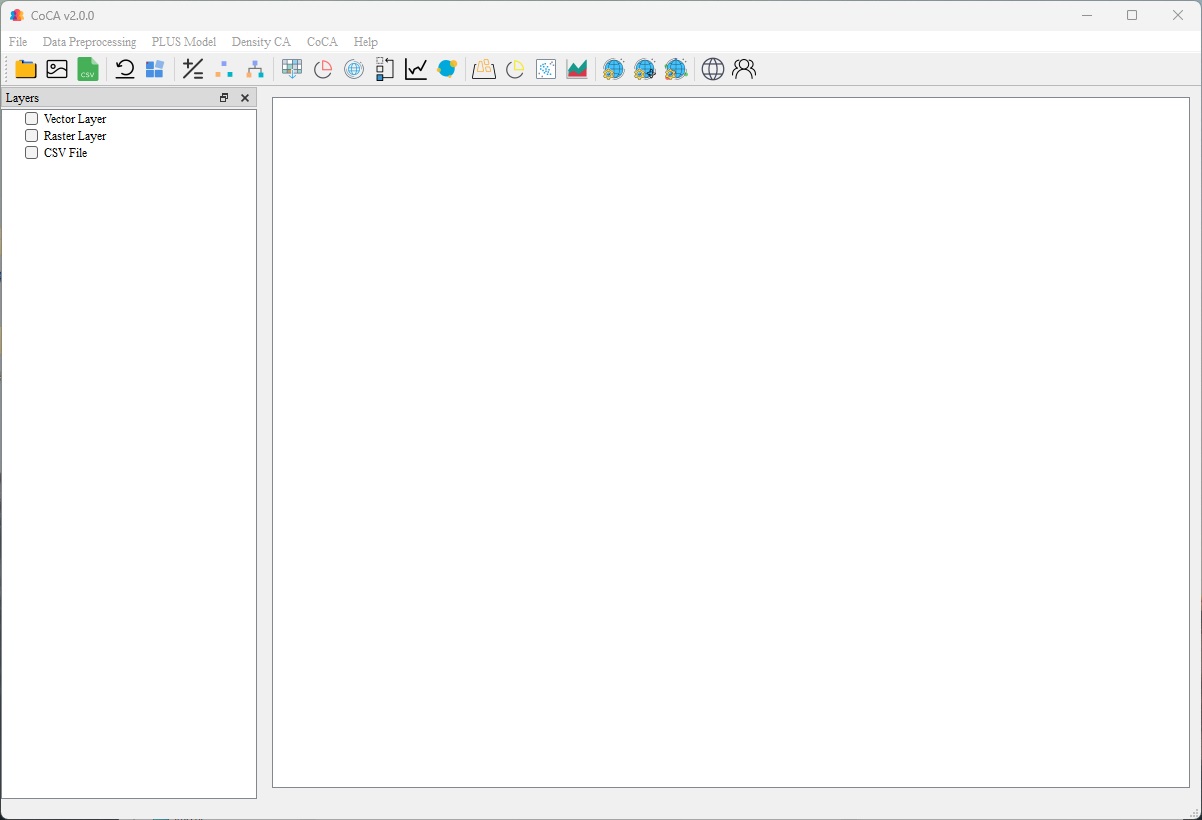标题:CoCA v2.1.0:基于元胞自动机模型的“土地-人口-经济”空间协同模拟平台
Title: CoCA v2.1.0: Spatial Cooperation Development Simulation Platform for "Land-Population-Economy" based on Cellular Automaton Model
介绍(Introduction)
CoCA v2.1.0,即基于元胞自动机模型的“土地-人口-经济”空间协同模拟平台,提供了离散型和连续性城市发展要素的模拟方法,并采用“层次递进”分步式动态驱动因素更新的策略,进行“土地-人口-经济”多要素空间协同模拟,为广大城市研究人员和城市规划人员提供帮助。
CoCA v2.1.0, Spatial Cooperation Development Simulation Platform for "Land-Population-Economy" based on Cellular Automaton Model, provides simulation methods for discrete and continuous urban development elements. It adopts a "hierarchical progression" step-by-step dynamic driving factor update strategy to carry out multi-element spatial coordination simulations of "land-population-economy". This model provides assistance to a wide range of urban researchers and city planners.
在CoCA v1.1.0 (https://www.urbancomp.net/archives/coca-v100)发布后,我们发现软件仍存在些许不足,如操作仍具有一定的难度、功能耗时过长、模拟精度较低等。为此,在v2.1.0版本中我们对相关功能进行了更新,重新设计了软件的界面,优化了部分功能模块。针对城市连续型要素模拟中的“灰度值”CA模型中城市中心点难以提取、模拟精度较低等问题,我们采用新的S曲线计算元胞密度值的方法替换了原始的Clark负指数模型方法,有效提高了人口、经济类连续性要素的模拟精度,也一定程度上降低了软件操作的复杂性。
Following the release of CoCA v1.1.0, We have found that the software still has some shortcomings, such as its operation being somewhat difficult, functions taking too long, and lower simulation accuracy. To address this, we have updated related features in version 2.1.0. For example: we have redesigned the software interface, optimized some function modules, and addressed issues in the "Density" CA model in the simulation of continuous urban elements where it is difficult to extract city center points and simulation accuracy is low. We replaced the original Clark negative exponential model method with a new method of calculating cell density values using an S-curve. This effectively improved the simulation accuracy of continuous population and economic elements and also reduced the complexity of software operation to a certain extent.
功能更新(Function update)


图2展示了总体发展概率计算模块,该模块基于随机森林的机器学习算法,计算出研究区域该类要素的总体发展概率。我们修改了该部分的计算算法:通过读取输入数据的属性表以判断数据类型,以匹配不同的发展概率计算方式,解决了以往版本中进行人口、经济类要素模拟时所计算出的发展概率数据无法使用的问题。
Figure 2 shows the overall development probability calculation module, which is based on the machine learning algorithm of random forests. It calculates the overall development probability of this type of element in the research area. We have modified the calculation algorithm for this part. By reading the attribute table of input data to determine data types, it matches different ways to calculate development probabilities, solving the problem in previous versions where calculated development probability data could not be used when simulating population and economic elements.

图3展示了城市连续性要素变化模拟模块,该模块实现了对人口、经济类连续性要素变化的模拟。在v1.1.0版本中,我们采用了Clark负指数模型计算当前元胞对应的城市发展密度,Clark提出负指数模型,城市的人口与经济密度等城市发展要素随着距离城市中心距离的增大趋于负指数形式衰减,因此需要进行提取城市中心点的操作。但该操作过程较为繁琐,且城市中心点的识别准确率较低,导致模型模拟效果不佳。为此在v2.1.0版本中,我们采用了S曲线的算法进行改进。更新后的版本无需进行城市中心提取操作,只需要放入研究区域的矢量边界数据即可。该算法研究的单元是一个范围边界,通过划分城市中心区与郊区以匹配不同区域的发展态势,能有效提升模拟精度,简化操作步骤。
Figure 3 shows the urban continuity element change simulation module, which implements the simulation of changes in population and economic continuity elements. In version 1.1.0, we used Clark's negative exponential model to calculate the current cell's corresponding urban development density. Clark pointed out that the population and economic density of a city tend to decay in a negative exponential form as the distance from the city center increases, so it is necessary to extract the city center operation. In version 2.1.0, we adopted the S-curve algorithm, which only requires inputting vector boundary data of the study area. The unit under study is a range boundary, which divides the city center and suburbs to match different areas' development trends, effectively improving simulation accuracy and simplifying operational steps.

图4展示了城市发展要素分步式模拟模块,该模块采用了“层次递进”分步式动态驱动因素更新策略进行单一城市发展要素的模拟。更新版本中我们优化了操作界面,修复了以往版本中无法正确识别所输入数据的类型,模型运行时偶尔闪退的问题,更新后该模块的运行稳定性得到提升。
Figure 4 shows the step-by-step simulation module for urban development elements. This module uses a 'hierarchical progression' step-by-step dynamic driver update strategy for the simulation of single urban development elements. It has optimized the user interface and fixed issues in previous versions where it could not correctly identify the type of input data, and occasional crashes during model operation. After the update, the stability of this module has been improved.

图5展示了密度模型参数模块,该模块是多要素协同模拟中密度模型的参数设置界面,我们优化了操作界面,新增了城市矢量边界数据的输入栏,修改了模型计算要素密度值的算法,使得模型操作流程得到简化。
Figure 5 shows the density model parameter module, which is the parameter setting interface for the density model in multi-element collaborative simulation. We have optimized the operation interface, added an input field for city vector boundary data, and modified the algorithm for calculating element density values in the model, simplifying the operation process of the model.

图6展示了CoCA v2.1.0软件在采用了S曲线算法后,进行“土地-人口-经济”多要素空间协同模拟的结果。
Figure 6 shows the results of the "land-population-economy" multi-element spatial collaborative simulation using the CoCA v2.1.0 software after adopting the S-curve algorithm.
软硬件系统需求 (Software and Hardware System Requirements)
内存 >= 4GB (RAM >= 4GB)
硬盘空间 >= 3GB (Hard Disk Space >= 3GB)
Windows 8.1及以上版本 (Windows 8.1/10 or above)
Visual C++ Redistributable 2017(Download here: Latest supported Visual C++ Redistributable downloads | Microsoft Learn)
软件下载(Binary Download)
内部下载
团队NAS下载地址-无密码版(Download Filepath from Team NAS - Password Free Version)
公开下载
下载地址(Click here to download)
目前软件仅供团队内部和合作团队测试使用,因此公开下载软件安装包有密码。
如果有其他需要,请联系姚尧老师( yaoy@cug.edu.cn )。
At present, the software is only for internal testing purposes within the team and collaborative teams, so there is a password for publicly downloading the software installation package. If needed, please contact Dr. Yao Yao ( yaoy@cug.edu.cn ).
软件使用说明书(Software Manual)
软件著作权(Software Copyright)
软件著作权展示:CoCA v2.0(Software Copyright Display: CoCA v2.0)
参考文献(Refereneces)
- Ongoing...
- Tu W, Gao W, Li M, et al. Spatial cooperative simulation of land use-population-economy in the Greater Bay Area, China [J]. International Journal of Geographical Information Science: 1-26. ( 站内链接(Internal Link) )
Q.E.D.









